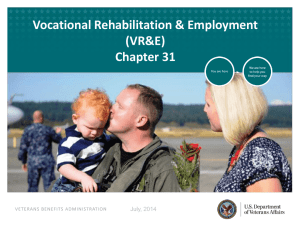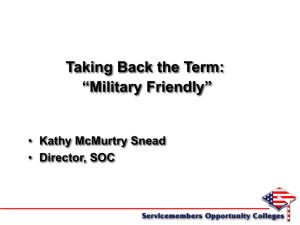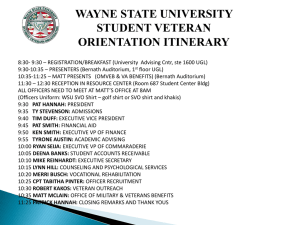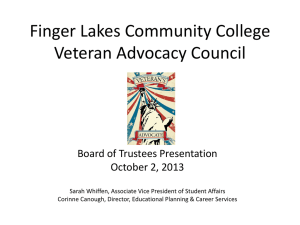Hospice-Veteran Partnership
advertisement
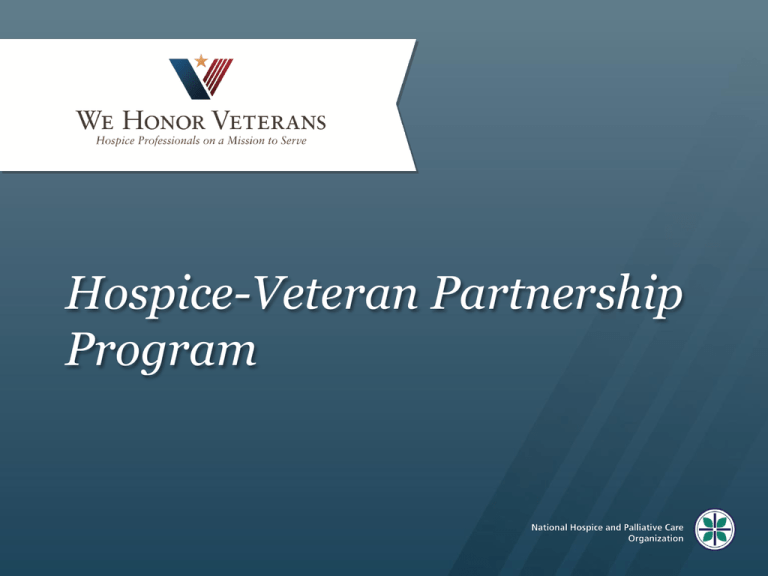
Hospice-Veteran Partnership Program Content • Overview of the Hospice-Veteran Partnership Program • Making the case to form an HVP • Strategies for HVP success • Tips for Getting Started and Succeeding • Examples • Resources Message from Tom Edes Department of Veterans Affairs • “We in the VA depend on you, community hospice agencies to deliver home care for our terminally ill patients. The VA does not intend to replicate the excellent system that is already in place for home hospice care and we in the VA must learn to collaborate with and learn from you.” National Collaboration • VA Hospice and Palliative Care Program Office – Dr. Scott Shreve, National Director – HPC program office staff – VISN Program Managers and Clinical Champions • NHPCO We Honor Veterans campaign – Emil Zuberbueler, Director, National Veterans Program – WHV program staff • Veterans Advisory Council • Council of States Hospice-Veteran Partnerships • Home: State hospice organization, coalition, VA VISN or facility • Leadership: Co-chairs, generally representatives from community hospice and VA • Structure: State-wide organization and coordination with local or regional HVPs around the catchment areas of VA faciities HVP Partners State Hospice Organizations End-of-Life Coalitions Community hospice agencies VISNs and VA facilities – VA Medical Centers – Community Based Outpatient Clinics (CBOCs) – Vet Centers • State Veterans Homes • Veterans Service Organizations (VSOs) • Community Veteran Organizations • • • • Veterans Health Administration 21 Veterans Integrated Service Networks www2.va.gov/directory/guide/division_flsh.asp?dnum=1 Why Are HVPs Important? • More than 1,800 veterans are dying every day – . . .but not much is known about end-of-life issues for this special population • The vast majority of veterans do not receive their health care from VA – . . .but community healthcare providers and organizations often don’t know who they are or how to reach out to them • Significant barriers exist – . . .but they can be overcome through communication and collaboration Volume of Veteran Deaths • Number of veteran deaths reached an alltime high in 2006 (664,842 projected Veterans deaths) • At least 600,000 deaths a year through 2016 • Less than 4% Veteran deaths (about 21,000/yr) will occur in VA facilities • HVPs are solving care coordination problems at the local, state and national levels www.va.gov/vetdata/Veteran_Population.asp Projected Veteran Deaths (2011) n = 648,354 <20 20-24 25-29 30-34 35-39 40-44 45-49 50-54 17 383 715 806 1,052 2,026 4,063 7,764 55-59 60-64 65-69 70-74 75-79 80-84 85-89 90+ 15,301 44,617 51,942 65,066 104,299 134,788 132,764 82,760 www.va.gov/vetdata/Veteran_Population.asp Total Projected Veteran Deaths by State (2011) Top 10 States represent 50% of Veteran deaths Highest #: 58,250 (CA) Lowest #: 1,060 (DC) Top 10 States with highest number of Veteran Deaths How Can HVPs Help VA? • Honors veterans’ preferences • Expands the interdisciplinary team • Increases VA staff knowledge of the Medicare Hospice Benefit • Frees up inpatient beds for incoming veterans • Shares the job of caring for Veterans with the community How Can HVPs Help Community Hospices? • Clinical Care – Honors veterans’ preferences – Improves communication and continuity – Expands understanding of veterans unique end-of-life issues • Administrative – Increases referrals – Improves payment for services – Clarifies interface between VA and community hospice policies and procedures How Can HVPs Help Veterans? • Honors Veterans’ preferences • Standardizes VA response to community hospices • Informs community response to Veterans’ unique end-of-life issues • Contributes to continuity and quality of care • Eliminates “charity care” for Veterans Getting Started with the HVP Toolkit Begin with a Planning Committee Identify potential partners Form a Leadership Committee Conduct Needs Assessment Develop strategic objectives and measure outcomes • Plan educational, program development and outreach activities • Work together to build solutions • • • • • (www.wehonorveterans.org) Potential HVP Projects • • • • • • Community Outreach Legal and Regulatory Issues Education and training for providers Research and Evaluation Member Recruitment Fundraising Strategies for Success • Strong support from VA leaders – Identify champion from each facility in state – Invite staff from CBOCs, State Veterans Homes, and VetCenters to participate – Secure support from VISN leadership – Include HVP in strategic planning efforts – Coordinate HVP activities within your VISN and with adjacent VISNs Strategies for Success • Equally strong support from the state hospice organization or coalition – Identify Community hospice champion – Invite all community hospices in state to participate – Secure board of directors support and appoint HVP community leader(s) – Establish an HVP standing committee or workgroup Strategies for Success • Acknowledge and respect all interest positions and cultural differences – WIIFM factor – Language of organization – Rules, regulations and SOP – Perceptions Understanding Differences VA Hospice Culture Quasi-military Community healthcare provider Role Provider and Payer Provider Funding Fixed appropriation and budget Entitlement - Medicare/ Medicaid hospice benefit; 3rd party reimbursement Accountability Congress Governing Body, CMS, Fiscal Intermediaries and State HVP Outcome Measures – 1st Tier Are we improving veterans’ access to hospice and palliative care? – # veterans being served by community hospices – HVP has the name and contact information of VA HPC liaison(s) at each facility in the state and makes this information available to all hospices in the state – # educational sessions among providers of care for veterans in all settings HVP Outcome Measures – 2nd Tier • Are we meeting veterans needs? – # education sessions/events for veterans and their families – Post death family satisfaction survey data collected and shared among providers – # referrals from community hospice to VA for assistance with care, benefits or services – # and % of community hospices that have written agreements with VA facilities and State Veterans Homes HVP Outcome Measures – 3rd Tier • Are HVPs paying attention to the strength and sustainability of their infrastructure? – Composition of HVP membership – # HVP projects ongoing and completed – # HVP meetings HVP National Program - Local Solutions • State lines and VISN boundaries are complex • Solution: form regional HVPs around each VA Medical Center in the state – Region includes the VAMC’s service area – Coordinate activities with your State HVP to ensure that everyone has the same information – Many benefits! Regional HVPs • HVP survey can identify perceptions and misunderstandings • Roundtable sessions drill down and identify barriers and opportunities • Solutions and best practices can be shared and “hard wired” into performance • Relationships strengthened through routine meetings and collaboration on specific tasks and objectives How to Start a Regional HVP • Establish a Regional or Local HVP leaders • Hold regular meetings • Report back to the State HVP and VISN palliative care leaders Regional HVP Start-up Activities • Schedule initial “Round Table or Open House” – Invite local VA facilities, community hospices, State Veteran Homes and others – Develop agenda collaboratively – Plan logistics carefully • Pay attention to local issues that affect the interface of VA with community providers in the region • Understand the different perspectives of individual member groups Regional HVP Agenda • VA Continuum of Health Care Services – Eligibility & Burial Benefits – VA Palliative and End-of-Life Care: Inpatient and Outpatient Services – VA Bereavement Program – Coordination of Care – MD orders for start of care – Medications and DME – Home Hospice Agency follow up – VA Purchased Home Hospice Care • Agencies Description & Services • Open Discussion Next Steps for Regional HVPs • Establish ongoing relationship • Create an e-mail group and send regular updates • Partner for training and education activities • Identify ways to increase hospice referrals • Improve coordination of clinical care Resources for HVPs We Honor Veterans website Military History Check List Military History Pocket Card Peace at Last: Stories of Hope and healing for Veterans and Their Families (Deborah Grassman, 2009) • State Hospice Organization websites • • • • VA Pocket Card Homepage www.va.gov/oaa/pocketcard/




